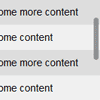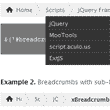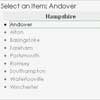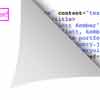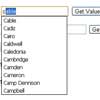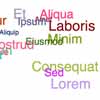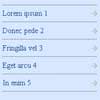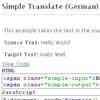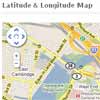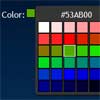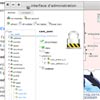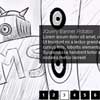IMPORTANT This repository is no longer maintained. We recommend using SimpleBar(https://github.com/Grsmto/simplebar) which is an actively maintained fork of trackpad-scroll-emulator. Thanks to those who contributed to this project.
Trackpad Scroll Emulator
A jQuery plugin that emulates OS X trackpad-style scrollbars in any browser or platform. Based on the scrollbars in the Rdio app.
1. What it does
Traditionally scrollbars are permanently displayed whenever an area of a webpage is scrollable. By contrast, scrollbars in OS X are hidden from sight, and revealed only when the user executes a swipe gesture with a 'magic' trackpad pointing device.
This plugin emulates OS X's UI pattern by replacing the browser's default scrollbars with a custom CSS-styled scrollbar that is only revealed when the user hovers over a scrollable element.
Modern browsers get a very accurate emulation of OS X's scrollbars, while less capable browsers miss out on a few bells and whistles such as rounded corners, opacity, and animated fades.
View a demo: http://jnicol.github.io/trackpad-scroll-emulator/
2. Dependencies
Trackpad Scroll Emulator has the following dependencies:
- jQuery
3. Usage
Include jQuery and Trackpad Scroll Emulator in your document. The paths and filenames may differ from those shown here:
<link rel="stylesheet" href="css/trackpad-scroll-emulator.css" /> <script src="js/jquery-1.7.1.min.js"></script> <script src="js/jquery.trackpad-scroll-emulator-1.0.min.js"></script> Mark up the content you wish to scroll like so:
<div class="tse-scrollable wrapper"> <div class="tse-content"> My content </div> </div> For horizontal scrolling add the class horizontal to the tse-content element:
<div class="tse-scrollable wrapper"> <div class="tse-content horizontal"> My content </div> </div> In the above examples the wrapper class is not required, but gives us a unique hook to use as a jQuery selector when initializing the plugin:
$('.wrapper').TrackpadScrollEmulator(); Options
Options can be applied to the plugin during initialization:
$('.wrapper').TrackpadScrollEmulator({ option1: value1, option2: value2 }); Available options are:
wrapContent
By default TrackpadScrollEmulator requires minimal markup, as shown above. When initialized it will wrap the tse-contentelement in a div with the class tse-scroll-content. If you prefer to include this wrapper element directly in your markup you can switch the default behaviour off by setting the wrapContent option to false:
$('.wrapper').TrackpadScrollEmulator({ wrapContent: false }); Default value is true
autoHide
By default TrackpadScrollEmulator automatically hides the scrollbar if the user is not scrolling. You can make the scrollbar always visible by setting the autoHide option to false:
$('.wrapper').TrackpadScrollEmulator({ autoHide: false }); Default value is true
Notifying the plugin of content changes
If you later dynamically modify your content, for instance changing its height or width, or adding or removing content, you should recalculate the scrollbars like so:
$('.wrapper').TrackpadScrollEmulator('recalculate'); Destroying the plugin
To remove the plugin from your element, call its destroy method:
$('.wrapper').TrackpadScrollEmulator('destroy'); Overwriting the content dimensions
The dimensions of the tse-scrollable wrapping element determine the visible dimensions of your content. Chances are that you'll want to change the width or height of the wrapping element, which can be done using CSS or JavaScript:
.wrapper { width: 250px; /* Example of overwiting default width */ } The demo bundled with Trackpad Scroll Emulator demonstrates how you might dynamically alter the dimensions of tse-scrollable using JavaScript.
Non-JS fallback
Trackpad Scroll Emulator hides the browser's default scrollbars, which obviously is undesirable if the user has JavaScript disabled. To restore the browser's scrollbars you can include the following noscript element in your document's head:
<noscript> <style> .tse-scrollable { overflow-y: scroll; } .tse-scrollable.horizontal { overflow-x: scroll; overflow-y: hidden; } </style> </noscript> 4. How it works
For the most part Trackpad Scroll Emulator uses the browser's native scrolling functionality, but replaces the conventional scrollbar with a custom CSS-styled scrollbar. The plugin listens for scroll events and redraws the custom scrollbar accordingly.
Key to this technique is hiding the native browser scrollbar. In modern browsers (i.e. WebKit) this is achieved simply by giving the scrollbar a width/height of zero using the ::webkit-scrollbar and ::scrollbarpseudo selectors. In other browsers the scrollable element is made slightly wider/taller than its containing element, effectively hiding the scrollbar from view.
5. Limitations
Trackpad Scroll Emulator can currently handle vertical or horizontal scrollbars, but not both simultaneously.
6. Credits
Obviously most of the credit for this technique goes to Rdio's developers. Rdio is a Backbone application, so their solution is a combination of Backbone, Underscore, jQuery, CSS and Bujagali (their own templating system). What I have done is to recreate the same scrolling functionality using only jQuery and CSS.
Credit is also due to Jonathan Sharp, who wrote the original function for measuring the width of the browser's scrollbar (http://jdsharp.us/jQuery/minute/calculate-scrollbar-width.php).
Additional contributors
Yoh Suzuki: wrapContent option
Adrien Grsmto: autoHide option
David Orr: jumpScroll method
Idan Hen: nested scrollable elements
